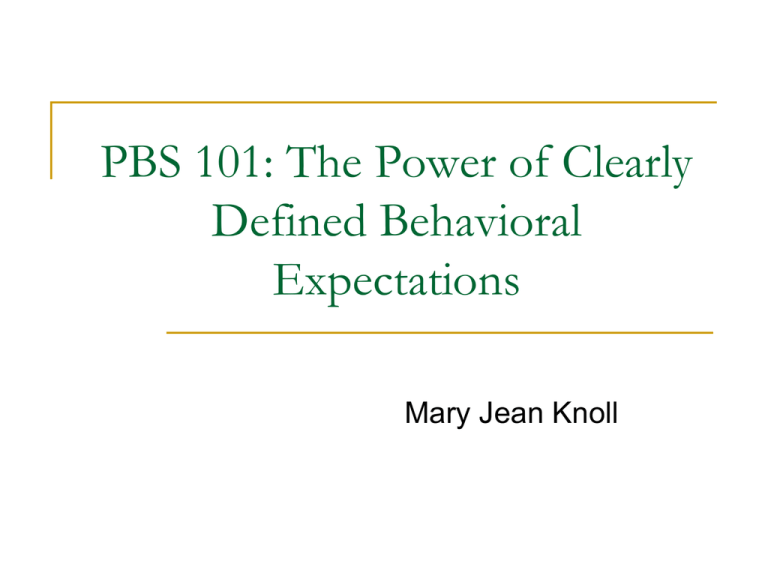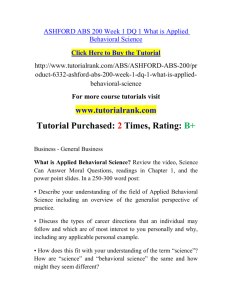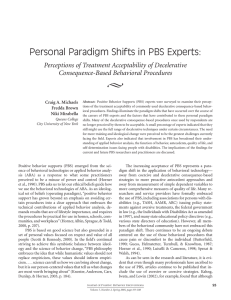PBS 101: The Power of Clearly Defined Behavioral Expectations
advertisement

PBS 101: The Power of Clearly Defined Behavioral Expectations Mary Jean Knoll Challenge… Schools are facing an increasingly challenging population of students with fewer financial resources How do schools enhance their capacity to respond effectively, efficiently, & relevantly to range of problem behaviors observed in schools. “Work Smarter” Goals of this Training Session Develop and/or strengthen existing PBS systems at school sites Examine the importance of defining and teaching common rules/expectations Address common implementation mistakes Team Process PBS is active, alive -- not static It’s not something we’ve done – it’s something we’re doing Requires regular team meetings with a team that represents ALL school staff Team keeps PBS alive through ongoing planning, support, and decision making to address needs as they arise Looking at data & maintaining & developing programs to meet needs Constantly asking: What can we do to address this need? What can we do to decrease this trend? How can we improve the current programs we have in place? School-wide Rules: Creating a Culture Guidelines for Developing School-wide Rules 3-5 Positively Stated Rules Rules should be: Broad enough to cover all potential behavior Positively stated Easy to remember Catchy – personalized to your school Example Be Safe, Be Responsible, Be Respectful Publicly Post School Rules Post expectations in prominent places Why Post ? Provides prompts for staff & students Increases accountability for staff and students to use language & follow rules Signs can reduce confrontation Plan Ahead (before school year) Before we can teach, reinforce, and enforce anything in our school or classrooms Clearly define: fair behavioral expectations & behavioral routines Based on the culture and physical layout of the school physical layout of the school student school schedule (breaks, lunch, recess, etc.) SETTING Expectations Teaching Matrix All Settings Hallways Playgrounds Cafeteria Library/ Computer Lab Study, read, compute. Sit in one spot. Watch for your stop. Assembly Bus Respect Ourselves Be on task. Give your best effort. Be prepared. Walk. Have a plan. Eat all your food. Select healthy foods. Respect Others Be kind. Hands/feet to self. Help/share with others. Use normal voice volume. Walk to right. Play safe. Include others. Share equipment. Practice good table manners Whisper. Return books. Listen/watch. Use appropriate applause. Use a quiet voice. Stay in your seat. Respect Property Recycle. Clean up after self. Pick up litter. Maintain physical space. Use equipment properly. Put litter in garbage can. Replace trays & utensils. Clean up eating area. Push in chairs. Treat books carefully. Pick up. Treat chairs appropriately. Wipe your feet. Sit appropriately. Defining Expectations Base expectations on school rules Outline expectations specific to each setting Positively stated expectations Seek input from staff, especially from those who work in specific settings Walk in the hallway v. No running Helps cue staff to recognize positive, not just negative behavior Focus on clear, specific behaviors Keep hands & feet to self v. Keep body under control Behavioral Expectation Grid Defining Expected Behavior across Classroom Routines School Rules Be Safe Responsible Respectful Classroom Keep hands and feet to self, know emergency drills Be prepared and participate Listen quietly, follow teacher directives, respect others thoughts Routine Class entry Walk quietly into the room and find seat Take out materials for this class, put other stuff on floor under desk Talk with an appropriate volume and respectful tone Routine Group Instr. Chair legs on floor Keep hands, feet and objects to self Be prepared and ready to participate Raise your hand to speak & wait patiently; follow teacher directives Hallway Pass Walk, look out for opening doors, sign out and take pass Go directly to/from the location of your pass Talk in a hallway voice, keep hands and feet to self Setting Fair & Reasonable Expectations Setting unreasonable expectations leads to inconsistency in enforcing expectations If I believe expectations are unfair or unreasonable, I will not enforce them Inconsistency = reduced credibility Lining up in hallway Be careful not to set up expectations that will not be enforced Teaching Behavioral Expectations & Routines Basic Strategy for Establishing Behavioral Routines 1. 2. 3. 4. 5. 6. Why? What is the purpose of the behavior Specify Student Behaviors Model Desired Behavior Coach - Lead - Practice – each individual student should have an opportunity to practice the routine Test/ Monitor Follow-up -- reinforce & reteach regularly Teaching Behavioral Expectations & Routine Make lessons fun and engaging, just like any lesson should be Make instruction developmentally appropriate Lessons can be more challenging with older kids; may rely more on verbal explanation of rules, with practice as a response for not following rules & regular reinforcement for following rules Although, practice is always very valuable Choose skills to teach wisely Presentation & attitude are important What great teachers do… Have students physically practice the behavior in the setting Simply talking about the rules or describing them is not nearly as powerful as having the student practice and “show you” they can do it Teacher should demonstrate the wrong way Have students explain why this is the wrong way Students should practice the right way What great teachers do… Learning takes frequent practice of “doing it the right way”, so we build in frequent opportunities to practice the right way to do it Students also need to know if they are doing it the right way or wrong way, so we… Provide immediate feedback when students do it the right way “great job of ….., that was just like we practiced” or provide corrective feedback if they do it wrong way and provide them more opportunities to do it the right way “whoa, remember what we practiced, can you show me what we’ve been practicing?” Difference between Teaching & Nagging Nagging = repeatedly stating to a student what they are doing wrong Reactive response Teaching provides students with support to ensure they can perform the expected behavior, with the opportunity to practice & clear feedback (positive feedback or corrective feedback) Can be used proactively or reactively Remember that good teaching is one of our best behavior management tools







